Texas Rancher Wages War Against Deer Euthanasia As Disease Spreads
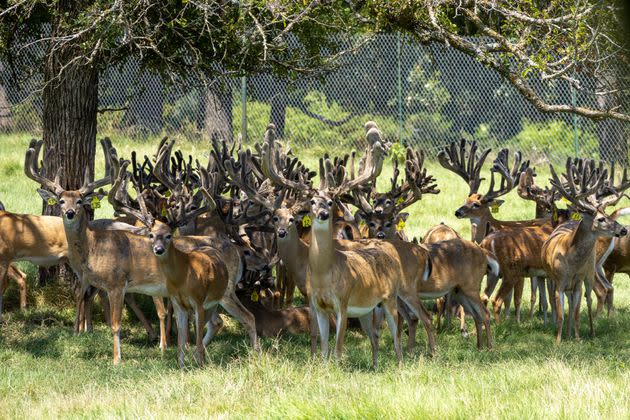
Captive deer huddle beneath an oak tree on RW Trophy Ranch, east of Dallas.
TERRELL, Texas ― On a July afternoon, Maree Lou Williams reached out to offer some animal crackers to a group of whitetail bucks clumped together under the shade of an oak.
Whitetail deer are notoriously skittish, but a pair walked toward her. They wore yellow ear tags, numbered 60 and 98, but she knows many of these deer by their given names. She bottle-fed some as underweight fawns, with legs as thin as pencils.
Tending to them has become bittersweet. The state of Texas wants to kill all of the roughly 500 captive deer at RW Trophy Ranch to contain the spread of chronic wasting disease, or CWD, a contagious brain disorder that wildlife officials widely view as the single greatest threat to the nation’s deer herds.
“It breaks my freaking heart,” Williams said, choking back tears as she recalled nursing a struggling fawn named Curly, whose low birth weight was apparently not linked to CWD. “Should I have just put him to sleep? Is it worth trying to save a 2-pound deer?”
CWD causes brain proteins called prions to misfold, leading to a prolonged death by neurodegeneration. The same phenomenon is called “mad cow” when it strikes cattle and Creutzfeldt-Jakob disease in humans. There are no confirmed cases of CWD jumping to humans, though every time a hunter develops a rare case of Creutzfeldt-Jakob disease, it invites speculation. The U.S. Centers for Disease Control and Prevention advises against eating CWD-contaminated meat.
RW Trophy Ranch has become the most contentious focal point in the state’s losing battle to control an outbreak of CWD at deer breeding sites that started 2½ years ago. The hunting ranch, owned and operated by Maree Lou’s father, Robert Williams, was among the first to see deer test positive on routine screening tests.
It’s not clear how CWD got onto the ranch, but it has spread rapidly. So far, 124 deer have tested positive for the disease since January 2021, making it the most concentrated outbreak in the state. The rise in positives there indicates “exponential growth,” according to Alan Cain, the big game director of the Texas Parks and Wildlife Department.
“Nearly every deer reported as a mortality is CWD-positive,” Cain said. “The concern is somehow it could get outside that facility and create a worse situation.”
Since the outbreak began, wildlife officials’ greatest fear has been that captive deer would spread it to the state’s wild deer, making it harder to contain. That may have begun to happen. This year, a wild doe outside the breeder pens at the high-fenced RW Trophy Ranch tested positive for CWD, along with a second deer killed at a release site and traced back to Robert Williams’ herd.
Because of the risks to wild herds, Texas wildlife officials typically kill every captive deer at breeding facilities that tests positive for CWD, then remove the top layer of soil from the pens and bury it 6 feet deep.
Nineteen deer-breeding facilities have had positive tests since early 2021. State game officials have depopulated seven of them. One infected site, Ox Ranch, can keep breeding deer while the state conducts research there. The prospect of depopulation looms over the others.
Deer breeders have abandoned the business en masse since the outbreak. The number of licensed deer breeders now stands at 635, according to state figures — a 32% drop since the current outbreak began in 2021. The number of Texas deer breeders peaked at 1,395 in 2014, the year before state officials first began to detect isolated cases of CWD in the state’s captive deer.
The only person so far who has flatly refused to let the state kill his site’s deer is Robert Williams, who is waging a lonely war against what he views as the indiscriminate and inhumane slaughter of the animals he’s spent three decades raising.
And in a surprising series of developments, Williams continues to thwart the state’s planned extermination of his herd. Four times, the state has served Williams with a 10-day notice that wildlife officials would euthanize the deer in his pens. All four times, his lawyer, Jennifer Riggs, has convinced a judge to grant a restraining order to keep the state from killing the deer.
State wildlife officials insist that Texas has always prevailed in legal disputes over euthanizing captive deer, which usually hinge on whether breeders have property rights to animals that the state classifies as wildlife. But after more than two years, the dispute over the fate of captive deer at RW Trophy Ranch remains unresolved as Williams wages a two-front legal battle to keep the deer on his ranch alive.
Williams has taken his fight against euthanization to Travis County, where the state capital, Austin, is located and where conflicts over the state’s authority to kill captive deer normally play out. It will take months before the appeals court rules in that case, according to Texas Parks and Wildlife Department attorney Todd George. If Williams loses again on appeal, he could try to take it to the state Supreme Court, but there’s no guarantee that it will hear the case.
But Williams is also contesting the state’s authority to kill the deer on his property in Kaufman County, southeast of Dallas, where a judge granted the most recent restraining order early this month. On Friday, Williams won an injunction barring the state from killing the deer on his property until after a jury trial scheduled for February of next year. “We’ve won the battle, but we haven’t won the war,” Williams said. “I haven’t done anything wrong.”
Either case tilting Williams’ way raises the prospect that a state court may recognize expanded rights for breeders, Riggs said.
“One of our primary concerns is that they can come in and kill the deer without giving due process,” Riggs said. “There’s no hearing to test whether the deer are really a threat to any other species. They don’t have to prove the basis for why they want to kill the deer.”
The resulting stalemate has left wildlife officials grasping for solutions as the disease spreads. The Texas Parks and Wildlife Commission adopted emergency rules designed to control the spread of CWD this week, including a two-mile containment zone encompassing the area surrounding RW Trophy Ranch. The National Deer Association, the country’s largest conservation group devoted to deer, urged its members this week to submit public comments in support of the changes.
“We don’t want to be creating any dangers or risks for wild deer based on the cultivation of captive deer,” said Torin Miller, the NDA’s senior director of policy. “We can’t control the movements of wild deer, but we can control the movement of captive deer.”
Williams has pitched state officials several offers other than letting state biologists onto his property to shoot his deer at night with noise-suppressed rifles, which Williams views as wasteful and cruel.
He’s asked to let out just the bucks that pass tonsil and rectal screenings for CWD. He’s angled for a research plan similar to the one that Ox Ranch got. He contends that they should at least let him euthanize the does by running them through the chutes he uses to vaccinate them instead of neck-shooting them as they scramble around their pens in the dark.
This summer, he offered to let wounded veterans come to his ranch and shoot them for free.
“I’d rather do that than let them put ’em in a hole, cover ’em up and waste ’em,” Williams said. “If they turn that down, they got hearts of stone.”
But wildlife officials consider the property’s CWD outbreak too widespread to remain viable as a research site, and they see live testing as too unreliable to screen a population in which the disease has gained so much ground. Even if they could come to an agreement on a herd plan for RW Trophy Ranch, it would require such low deer densities that it would make little business sense to keep running it as a game ranch. In cases like Williams’, state officials point breeders toward federal compensation funds that offset only a small fraction of the losses.
“I said, ‘I don’t want your money ― I’m not broke,’” Williams told HuffPost. “I may be broke before it’s over, but I don’t want to kill my deer.”
Bambi Jr.
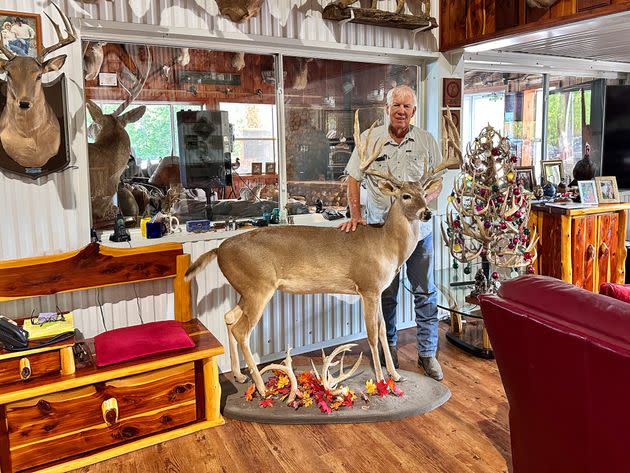
Robert Williams, shown here in a display room at his RW Trophy Ranch, says he offered a compromise to let wounded veterans come to his ranch and shoot the deer for free rather than have state agents mass kill the animals.
Robert Williams, 84, has a full head of cotton-white hair and the ruddy complexion and leathery skin that come from a lifetime of working under the Texas sun. The 1,500-acre hunting ranch he bought in 1994 sits on a rolling plain in northeast Texas, dotted with stands of post oaks and pecans and enclosed by high fences to keep the deer inside.
Wild native deer live on the property, but he raises the ones that hunters pay to chase in a set of pens totaling 68 acres, dotted with ponds and metal fixtures to cast shade.
Williams takes the most pride in a lineage that traces its origins to a buck named Bambi. He bought that buck more than 30 years ago, when he was still on a 9-acre property in Sunnyvale, raising cattle, elk and axis deer — a long-antlered exotic imported from India by game ranches and now common in Texas.
“Old Bambi was mean,” Williams said. “He whipped everything there. In fact, he jumped on me one day. He would’ve killed me now.”
Bambi rumbled with an axis deer one day and took a tine to the gut, killing him. But his son, Bambi Jr., laid the genetic foundation for the kind of wide-framed, classically antlered buck that Williams likes best.
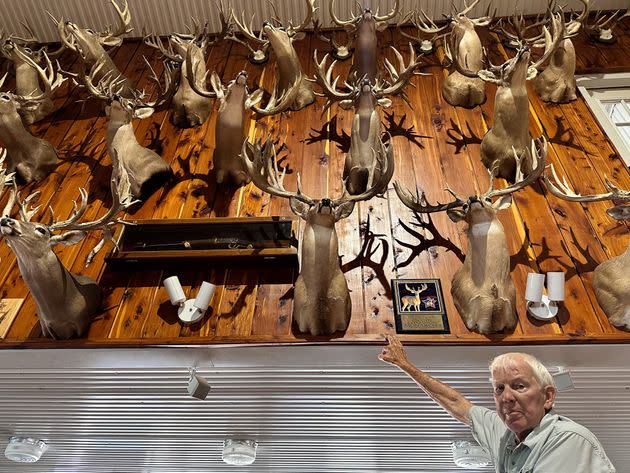
Robert Williams, owner of RW Trophy Ranch, stands before a wall of shoulder mounts made from antler sheds of deer he's bred over a three-decade career.
By the time Bambi Jr. had grown into a 3-year-old buck with a respectable 170-inch rack, Williams had bought a much larger property and started focusing his attention on raising whitetails. Passers-by would stop to watch Bambi Jr. and the rest of the herd through the chain-link fence.
One admirer offered Williams $1,000 for does sired by the buck. As his herd grew, those offers kept getting larger.
“I remember the first time one of my does brought $25,000, I just couldn’t believe a deer would do that,” Williams said. “Then I sold a buck one time, and it got $260,000.”
A Texas Business
The business Williams built was made possible by the unusual laws governing deer in Texas. In the United States, wildlife like whitetail deer are considered a public resource, owned by the citizens and managed by state game agencies. At least five states forbid holding deer in captivity. At least 20 states allow captive deer breeding but treat privately held deer as livestock. Texas is one of about a dozen states that allow private citizens to breed captive deer while still classifying the animals as wildlife.
The unusual arrangement allows ranchers to selectively breed deer while supplementing their feed, making it possible to grow bucks far larger than those in the wild. Deep-pocketed hunters pay prices topping $20,000 for the ability to shoot one.
That system has created a lucrative trade in captive deer and big buck semen to feed a high-fenced hunting market that blurs the lines between livestock and wildlife. Boone and Crockett, the conservation group that developed the most widely used system for scoring big game animals in 1906, does not recognize pen-raised deer or those killed behind high fences.
And in recent years, conservation groups have become increasingly concerned about the rate of CWD infection in breeder facilities.
Wildlife biologists worry that uncontrolled spread of the disease may threaten the health of entire herds of cervids, a family of mammals that includes deer, elk, moose and caribou.
CWD was first detected in Texas in wild mule near the border with New Mexico in 2012. Four years later, the disease first appeared at a breeder site in Medina County, west of San Antonio. The next year, free-ranging deer began testing positive in the same county.
But the last three years have dealt a nearly existential blow to Texas deer breeders as the disease continues to crop up at isolated breeding sites, often with no clear explanation. Because diseased prions can remain in the environment for years and survive temperatures up to 1,832 degrees Fahrenheit, some speculate that vultures spread the disease by feeding on infected deer carcasses, then vomiting diseased prions into water tanks used by deer and livestock.
Whatever the case, deer breeders keep animals clustered tightly together and routinely buy and sell deer across the state, allowing the animals to travel much farther than they would naturally. Both practices allow contagious diseases to spread much faster than they do in the wild.
Breeders who receive any animals from a CWD-positive site typically lose their ability to transport deer. Emergency rules adopted last month by the Texas Parks and Wildlife Department require all captive deer turned out for hunters to retain their ear tags and subjects them to mandatory CWD testing.
“Nobody is out to get breeders — it’s the situation we’re in,” said Justin Dreibelbis, the chief executive officer of the Texas Wildlife Association, a conservation group. “We just keep getting positive facility after positive facility. We keep moving deer around the state in a trailer at 70 mph, way faster than a deer can naturally travel. If we’re serious about managing this disease, let’s look at the most serious risk and address it.”
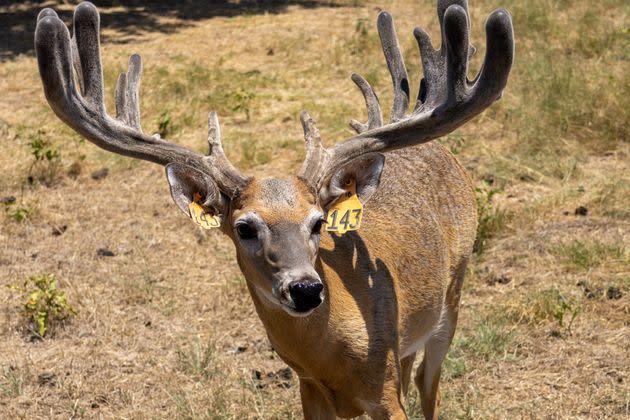
A captive deer roams across a pen at RW Trophy Ranch in Kaufman County, Texas.
While breeders command a unique and profitable corner of the hunting industry, they account for only a small part of the hunting economy as a whole, Dreibelbis noted.
Texas is home to more than 5 million deer, with breeding facilities accounting for only about 105,000, according to a survey released by Texas A&M University in May. Only 5% of Texas landowners supplemented their native herds with captive deer, the survey said.
Williams argues that the biologists at Texas Parks and Wildlife and low-fenced ranchers want to put breeders like him out of business because the breeders grow such big deer.
“The whole deal is they’re wanting to put deer breeders out of business,” Williams said. “It’s because we raise bucks with huge antlers. And if we were only raising little 160-, 170-, 180-inch bucks, none of this would have ever happened.”
Dreibelbis, however, said the response really is about safety.
“I don’t want to see anyone go out of business or lose money — no one wants to see that.” he said. “But at the end of the day, we have a hunting economy in Texas that revolves greatly around whitetail deer, the vast majority of which are native, free-ranging whitetail deer. We have to remain focused on our native whitetail deer. While that may be unfortunate for a few, I think we have to keep that state deer herd in mind.”
‘I’m Not A Bit Worried About It.’
Williams views concerns about CWD as overblown. Deer die in droves of much more common diseases, such as epizootic hemorrhagic disease and bluetongue, without prompting the same outcry as CWD. The deer in his pens have tested positive for CWD only after dying of something else, like pneumonia, he said.
Though always fatal, deer rarely live long enough to die of a slow-moving neurodegenerative diseases like CWD. Its population-level effects remain unclear, though some researchers have shown that CWD-infected deer die at higher rates than those without the disease, likely because neurodegeneration makes them more vulnerable to predators, including human hunters.
Many biologists and wildlife officials worry that if left to spread unchecked, CWD could cause deer populations to tumble. And some suspect that with enough exposure, the disease could jump to humans, like mad cow disease did.
The incidence rate of Creutzfeldt-Jacob disease has slowly crept up from 1 case per 1 million people in 1980, the global average, to about 2.5 cases last year, according to the CDC.
Improved identification and reporting of an unusual disease could account for that growth, though two clusters of a total of five cases in Michigan last year may indicate that human infection rates of CJD are much higher than public health officials currently estimate and may be associated with eating venison.
But some biologists share Williams’ skepticism. Few deer live longer than five years in the wild. That population turnover limits the spread of all diseases, according to Horace Gore, a former deer specialist at Texas Parks and Wildlife.
“I don’t have any concerns about the future of whitetail deer and deer hunting whatsoever,” Gore said. “There’s no world in which CWD can be a futuristic detriment to whitetail deer or deer hunting. There’s too many factors that control it. The turnover rate is one.”
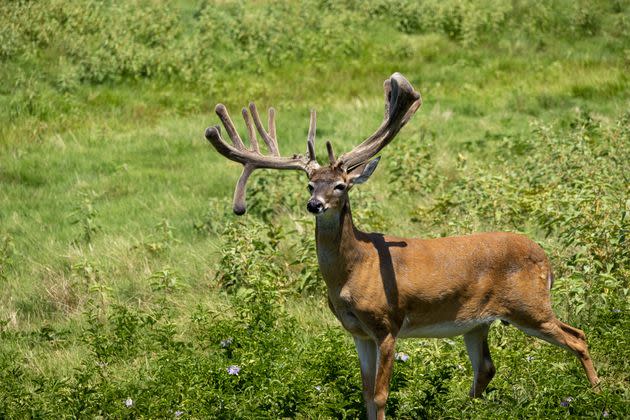
Some of the whitetail deer bred for hunting at RW Trophy Ranch have tested positive for chronic wasting disease, CWD.
He’s also not concerned about the potential for CWD to jump to humans. If it had that potential, we’d see the disease jump more frequently, Gore contended.
Williams doesn’t worry that the disease will jump to humans either. Last hunting season, he and his cousin shot six native does on the ranch, then took them to a CWD check station that wildlife officials had established in the area. One of the does Williams shot, with a fat body and worn teeth indicating mature age, returned a positive test the next month — the first CWD case detected in a free-ranging deer in Hunt County.
Texas wildlife officials viewed the CWD-positive doe as disturbing evidence that the disease had spread from his penned deer to the wild deer outside. Williams saw it as one more reason why he should be allowed to release his bucks.
“Supposedly I got CWD deer here on the ranch,” Williams said. “Why would they care if they turn these bucks out and let these servicemen, who put their lives in harm’s way and got crippled and broke up, and let ’em shoot ’em, free. Let’s charge ’em nothing.”
He had already had the dead doe processed into jerky by the time the CWD test came back.
“I eat some of that jerky every week,” Williams added. “I’m not a bit worried about it.”
The fact that the state classifies captive deer as wildlife has always been a massive business risk for breeders, making it difficult to go to court to contest decisions to kill off a captive herd.
Breeders have tried to convince Texas courts that they have a property interest in the deer they raise.
But Williams’ lawyer, Riggs, aims to break new legal ground by arguing that Williams still has rights as a landowner that may protect the deer on his property. And she contends that state wildlife officials don’t test enough wild deer to prove that breeders are the ones causing the problem.
“They don’t have the evidence to support what they’re doing,” Riggs said. “This whole idea that breeder deer are going to give it to free-ranging deer falls apart if the free-ranging deer already have it.”
For now, Williams can only wait. Unable to turn out bucks for hunting season and unwilling to euthanize them, the game ranch stands in limbo, racking up massive costs. He keeps four full-time employees on staff and spends between $15,000 and $20,000 each month on feed alone.
The value of his ranch, where he lives in a stately brick house with four white columns, plummeted after the infection showed up. No deer breeder would buy it. The proliferation of CWD and the state-imposed restrictions that come along with that make it hard to sell as a game ranch.
“It’s cost me hundreds of thousands of dollars being bullheaded and not letting them kill ’em,” Williams said. “They claim deer belong to the people. But people don’t come and feed my deer and take care of them.”
